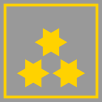Ranks of the Austrian Red Cross
Each exercising member of the Austrian Red Cross has a rank depending on the assignment or seniority . The ranks are uniform nationwide.
In the rescue and ambulance service as the largest service area of the Red Cross in Austria, the ranks of the emergency personnel are of particular relevance, as they indicate to the operations manager if personnel through additional training are qualified to take on a managerial function in the coordination of larger operations.
Rank badge
The identification on the uniforms is carried out with slip-on loops on the operational clothing. On the gala uniforms (also known as "dress uniform" or "A uniform") that are worn on festive occasions, there used to be sewn distinctions , which have now largely been replaced by loops. All officer ranks also wear collar tabs on their dress uniform.
The appearance of the rank badges is generally based on the pattern customary in Austria, especially that of the fire brigade : silver and gold "stars" (actually edelweiss) and bars and boxes. In some cases, however, there are minimal differences between the various organizations, for example in the Red Cross a gold bar is used instead of two silver bars for high non-officer ranks (first-aid officer, senior medical officer and chief medical officer).
Colors and functions
The background color of the slip-on loops provides information about the function of the carrier:
| colour | function |
|---|---|
| gray , red , white (depending on the color of the uniform) | Emergency personnel (ambulance and ambulance service) |
| blue | official |
| black | doctor |
| violet | curate |
| lilac | pharmacist |
| green | Veterinary |
For the various functions, identified by the different background colors of the hanging loops, different regulations and conditions apply as a prerequisite for the award of a grade. The strictest regulations regulate the ranks of the operational personnel. For example, with every high non-officer rank (e.g. platoon leader, medical officer) completing additional training is compulsory. In order to achieve an officer rank in the field of operational personnel, the train driver courses and then the medical master courses must first be completed before the officer course can be completed, which ends with a written officer's thesis and a final examination before a committee.
In contrast to operational personnel, ranks for officials are in principle not tied to additional training. Completion of modules from management training courses 1, 2 and 3 is recommended for officials such as local or district office managers, but is not compulsory. The ranks for doctors, curates, pharmacists and veterinarians are not necessarily linked to the strict requirements that apply to emergency personnel.
Special features of the dress uniform
The going out or gala uniform has some special features, as collar tabs are worn here in addition to the slip-on loops from officer rank. For non-officer ranks, a small metal red cross is worn in the buttonhole of the collar instead of the collar tab.
| function | Collar Tabs | Slip-on loops (coat) |
|---|---|---|
| Emergency personnel | Gray | Gray |
| National association staff & full-time professionals in the district | gray on blue | Gray |
| Officials of the regional association, district, or local office | blue | blue |
| Austrian Red Cross staff | gray on red | red |
| Functionaries of the Austrian Red Cross | red | red |
| doctors | black | black |
| Chief physician of the regional association | black on blue | black |
| Head of the Austrian Red Cross | black on red | black |
| pharmacist | lilac on black | black |
| Veterinary | green on black | black |
| curate | violet | violet |
Deviations in the regional associations
Some regional associations do not exhaust all possibilities of the framework regulation of the Austrian Red Cross: For example, in the Styrian regional association, gray (emergency personnel) or blue (officials) slide-on loops are worn on operational clothing (and also on the shirt or blouse for the uniform) in order to make it easier to recognize of the emergency personnel. Likewise, all emergency personnel in the Tyrolean regional association only wear gray for the rescue and ambulance service, white and red loops are not used.
Gray as a "historical relic"
The gray background of the slip-on loops can be seen as a historical relic: The original color of the Red Cross operational clothing ("C-Uniform") was gray. Until the late 1990s and in some regional associations even beyond, large parts of the operational clothing were gray. The gray uniforms were gradually removed and replaced by red operational clothing. Today all uniforms in the rescue and ambulance service are in red and white, but gray is still worn by units of the disaster relief service and occasionally by employees of the blood donation service.
Practical significance of the ranks
Regardless of the service area, the ranks are not of great importance in normal service operations, since the declared aim of the Red Cross is to maintain and promote a collegial cooperation between employees. In principle, there is no obligation for employees to also wear a rank, which means that identification by means of slip-on loops on operational clothing is not mandatory.
The ranks are particularly important in the ambulance and ambulance services, as they allow conclusions to be drawn about the level of training of an employee: The major accident regulation of the Red Cross, which is applied throughout Austria, stipulates that in the event of a large-scale deployment, the highest-ranking employee on the vehicle should have it arrives first at the accident site, takes over the provisional operations management . When the head of operations arrives (a higher-ranking employee who is responsible for supervision - see below), the provisional head of operations hands over the operations command to the head of operations. The head of operations can now deploy employees with additional training (e.g. train driver or paramedic) for special tasks such as setting up and / or managing a medical aid station.
At every district office of the Red Cross that operates ambulance and ambulance services, there is round-the-clock supervision by a so-called "Duty Officer" (OvD), sometimes also referred to as "Duty Officer" or simply "Duty Officer". This is an experienced employee at least with the rank of standby commander, who is qualified to take on a managerial role by completing additional training (management training 1–3). He or she is responsible for coordinating the operations in the area of responsibility and at the same time takes over the management of operations at the scene of larger operations. In large districts, officers of the local office are also assigned to the individual local offices; an officer rank is not mandatory for this function, so the task can also be taken over by employees with high non-officer ranks. Since the Red Cross in Vienna only has a comparatively small number of departments with a small number of operational resources, as the rescue service there is mainly provided by the Viennese professional rescue service , there is a main inspection officer (HIO) on duty instead of a separate OvD for each district office, who is responsible for holds all districts of the state.
Rank designations and conditions of carriage
The promotion of all ranks up to and including the rank of "State Rescue Council" is incumbent on the President of the respective regional association. At the suggestion of the President of the respective regional association, the promotion of “Federal Rescue Council” is the responsibility of the President of the Austrian Red Cross, who is also responsible for the promotion of the members of the General Secretariat.
In principle, there is no right to promotion in the Red Cross, an employee is always “suggested” for promotion (e.g. due to having completed a course, an election, etc.). Likewise, in rare cases, serious misconduct can lead to an employee being demoted.
Emergency personnel in rescue and ambulance services
| Rank designation | Image of the slip-on loop | necessary training | possible service position | comment |
|---|---|---|---|---|
| Non-officer ranks | ||||
| Trial helper |

|
Basic first aid course | from joining the ambulance and ambulance service | |
| helper |

|
Completion of paramedic training | Troop / vehicle commander | End of probationary period |
| Senior helper |

|
Troop / vehicle commander | two years as a helper | |
| Main helper |

|
Troop / vehicle commander | two years as a senior helper | |
| Platoon leader |

|
Management training part 1 | Group commander; Head functions within a medical aid center | no minimum period of service required |
| Chief officer |

|
Group commander; Head functions within a medical aid center | three years as a train driver | |
| Main platoon leader |

|
Group commander; Head functions within a medical aid center | three years as senior platoon leader | |
| Paramedic |

|
Management training part 1 and 2 | Platoon commander; Head functions within a medical aid center , such as head of triage , head of transport or similar. | no minimum period of service required |
| Senior medical officer |

|
Platoon commander; Head functions within a medical aid center , such as head of triage , head of transport or similar. | three years as a paramedic | |
| Chief medic |

|
Platoon commander; Head functions within a medical aid center , such as head of triage , head of transport or similar. | three years as senior medical officer | |
| Officer ranks | ||||
| Readiness commander |

|
Management training part 1, 2 and 3 | Department commander, head of a medical aid station, commander of a Red Cross aid unit | no minimum period of service required |
| Department Commander |

|
relevant training | Department commander, head of a medical aid station, commander of a Red Cross aid unit | five years as a standby commander |
| Column commander |

|
relevant training | Column commander | five years as department commander |
| Rescue council |

|
relevant training | S3 / Chief of Staff / BezRKdt. Deputy | five years as a column commander |
| Chief Rescue Council |

|
Management training part 1, 2 and 3 with GU, special deployment / staff | District Rescue Commander | upon appointment |
Ranks for service officers
Ranks for doctors
| Rank designation | Image of the slip-on loop | necessary training | possible service position | comment |
|---|---|---|---|---|
| Officer ranks | ||||
| Readiness commander |

|
Completed degree in human medicine | Mediciners | |
| Department Commander |

|
License to practice medicine , with ius practicandi or specialist medical diploma according to the Medical Act (also applies to all higher ranks in this section). | Red Cross doctors | |
| Column commander |

|
According to the Doctors Act and national guidelines | Emergency doctors | |
| Rescue council |

|
According to the Doctors Act and national guidelines | Head emergency doctor
District office Red Cross doctor |
|
| Chief Rescue Council |

|
relevant training | District Red Cross doctor | upon appointment |
| State Rescue Council |

|
relevant training | Departmental Red Cross doctor
State or federal deputy physician |
upon appointment |
| Federal Rescue Council |

|
relevant training | State Chief Doctor
Bundeschefarzt |
upon appointment |
Ranks of the local office functionaries
Ranks of management staff and functionaries at the district offices
In the event that management personnel are also emergency personnel and the prescribed courses have been completed, those affected wear either gray, red or white loops (as described above) instead of blue instead of blue.
Ranks of management staff and functionaries in the regional associations
Functionaries who are also members of the management, but do not participate in the state rescue team or similar. and thus have not completed the prescribed training, instead of gray, white or red ranks for emergency personnel, ranks with a blue background.
Ranks of the presidents and vice-presidents of the regional associations and the Austrian Red Cross
Ranks of the control center dispatchers
Ranks for the Red Cross Youth
The Red Cross Youth as part of the Austrian Red Cross also awards “ranks” to the young members. These are also subject to conditions and essentially show how long the person concerned has been a member of the Red Cross Youth and whether they have successfully completed a basic first aid course.
| Rank | Image of the slip-on loop | necessary training |
|---|---|---|
| 1 year |

|
|
| 2 years |

|
Completed EH basic training |
| 3rd year |

|
|
| from the 4th year |

|
Honor ranks
Red Cross employees aged 65 and over have the option of being awarded a so-called honorary degree. Honorary ranks serve to show members who are no longer in active service a token of appreciation and recognition for their achievements. The prerequisite for the award of such a degree of honorary service is that the employee has actively worked in the Red Cross for at least 15 years before retiring from active service. In such a case, the rank that was held last can be awarded as an honorary rank and thus continue to be used. From this point in time, however, further transport is definitely no longer possible.














